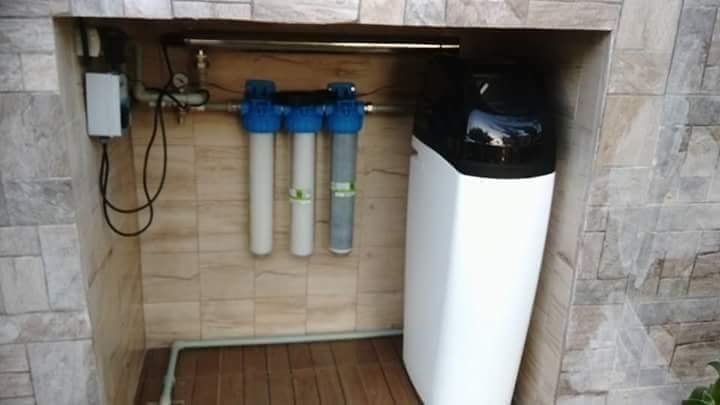
Softening systems protect the devices you use against the damage of calcareous water, while also preventing narrowing, clogging, puncture and wear caused by lime in your general pipelines. The basic working principle of water softening systems is Calcium (Ca+2), which causes hardness in water by ion exchange method and
It helps to remove magnesium (Mg+2) ions from water. It is the removal process of sodium (Na+1) ions in cationic resin by replacing them with calcium and magnesium ions. After this process, the saturated resin should be regenerated with salt water in a time or flow rate controlled regeneration process. With the careful work of our engineers, Smith offers you customized solutions according to your usage area and needs. Water softening solutions tailored to your needs In the industrial field, you can increase the efficiency in the process stages by using soft water and extend the working life by protecting your devices.
In sectors where the need for soft water is important, the lime layer caused by hard water causes heat and energy loss, as well as the formation of serious failures in your machines and high financial losses. Smith high capacity water softening systems are specially designed for you. While offering you the appropriate solutions, our expert team projects softening systems where you can get the highest efficiency by taking into account factors such as water hardness, consumption amount, resin coefficient, regeneration period and automation system. Since the resulting soft water is not wasted by mopping up calcium ions, it requires less soap for the same cleaning effort. Soft water also extends the life of the plumbing by reducing or eliminating limescale build-up in the fittings and fittings.
Water softening is usually carried out using lime softening or ion exchange resins, but it is increasingly done in or using systems. Ingredients The presence of certain metal ions, such as calcium and magnesium, in water as essentially , and as such, causes various problems. It can pollute and increase hard, causing its accumulation. In industrial-scale water softening plants, wastewater from the reproduction process can precipitate the scale, which can affect sewage systems. The feeling of slipperiness experienced when using soap with soft water occurs because soaps tend to bind to oils in the surface layers of the skin, making it difficult to remove soap molecules with simple dilution. In contrast, in harsh water areas, rinse water contains calcium or magnesium ions that form insoluble salts, effectively removing residual soap from the skin, but potentially leaving a coating of insoluble stearates on the surfaces of bathtubs and showers, often called so-called stearies. The desirability of these competitive effects varies according to personal preferences, and those who dislike the effects of soft water, such as , or , may choose to harden the water by adding chemicals.
The most common method to remove water hardness or is based on reverse osmosis. Other approaches include precipitation methods and sequestration with the addition of its substances. Conventional water softening devices intended for home use depend on an ion exchange resin, in which the "hardness ions" (e.g. Ca2 + and Mg2 +) are replaced by sodium ions. As described by NSF/Standard 44, ion exchange devices reduce hardness by replacing magnesium and calcium (Mg2+ and Ca2+) with sodium or potassium ions (Na + and K +). Ion exchange resins, in their form, are a functional component of domestic water softening units. Ion-exchanger resins are organic polymers containing anionic functional groups, to which divalent cations (Ca++) bind more strongly than monovalent cations (Na +). inorganic substances also exhibit ion-exchange properties. These minerals are widely used in laundry detergents. Resins are also available to remove carbonate, bicarbonate, sulfate ions and absorbed hydroxide ions from resins. When all existing Na+ ions are replaced with calcium or magnesium ions, the resin must be charged by using Ca2+ and Mg2+ ions using a solution of sodium chloride or sodium hydroxide, depending on the type of resin used. For anionic resins, the regeneration typically uses a solution of sodium hydroxide (lye) or potassium hydroxide. Ion exchange containing unwanted calcium and magnesium salts is typically discharged into the system that is elute from the column. Lime softening is the process that is added to hard water to make it softer. It has many advantages over the ion exchange method, but is mainly suitable for commercial purification applications. Chelators are used in chemical analysis, as water softeners, and are components found in many commercial products. is used in soaps, personal care products, and to soften water.
A commonly used synthetic chelator is ethylenediaminetetraacetic acid, which can be found as tetrasodium or bisodium salt, due to environmental and aquatic toxicity concerns regarding its widespread use in household and personal care products, alternatives such as sodium phytate/phytic acid, tetrasodium glutamate diacetate and trisodium ethylenediamine dissuccinate are finding more widespread use. Since Ca2+ and Mg2+ are available as non-volatile salts, they can be extracted by distilling water. Distillation is very expensive in most cases. its juice is soft because it is naturally distilled during evaporation, condensation and precipitation.
- July 17, 2021
- 623
- 0
- WATER SOFTENING SYSTEMS